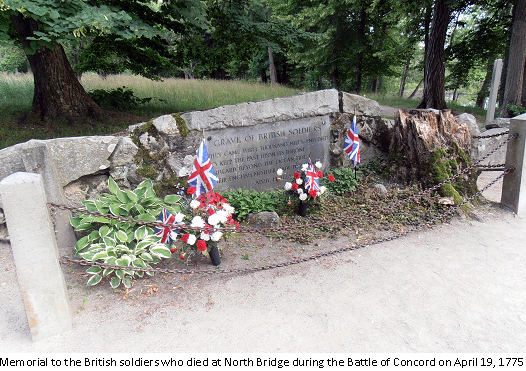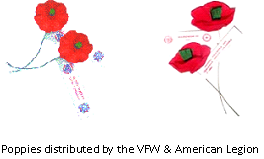British Flags to Remember British Soldiers

A visit to Boston offers many treasured experiences. Recently we visited the North Bridge near Concord, site of the first battle of the American Revolution where the Americans fought back.
At Lexington Green the Americans retreated after a few of their comrades fell in the hail of fire when some unknown musket fired the first round. At the North Bridge, British soldiers fell in retaliation, and more Red Coats fell as the columns made their way back to Boston. There is a small memorial at the Bridge to the fallen British. I have noted the memorial on each visit I have made to the North Bridge. A poem entitled “Lines” by an American Poet James Russell Lowell written in 1849 to describe the British graves:
At head and foot, an unhewn stone,
O’er which the herald lichens trace
The blazon of Oblivion.
In 1910 residents of Concord placed a plaque at the graves using other lines from Lowell’s poem:
Grave of British Soldiers
They came three thousand miles and died,
to keep the past upon its throne:
Unheard, beyond the ocean tide,
their English Mother made her moan.
April 19, 1775
With each of my visits to Concord, the decorations at the little monument have become more elaborate, and they are for me very touching. In the past there have been small stick flags displaying the current version of the British Union flag. On my most recent visit I found two carefully sewn British Union flags showing the flag design from the period of the American Revolution, the flag under which the fallen British soldiers fought and died. These flags honor British soldiers who died far from home.
Amid flags, flowers and plants was placed a wreath of red poppies. Members of the Veterans of Foreign Wars and members of the American Legion have distributed poppies each Veterans’ Day over the years to acknowledge contributions to veterans’ charities. Red poppies are also popular emblems of war dead in Britain today, but mainly for those who died in WWI and after. Someone is taking very good care of this memorial to British troops killed in the American Revolution. Perhaps a British transplant to the Concord area. Whatever the case, it is a fitting and poignant memorial.

